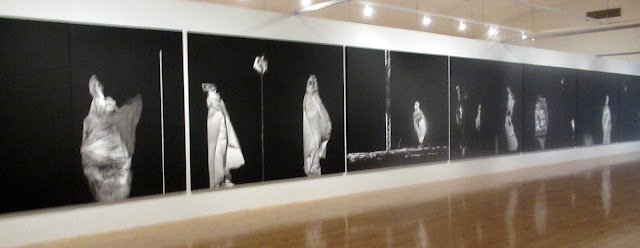George Hadjimichalis : a retrospective - 2, at the Benaki Museum, Pireos.
This is the second post on this exhibition and I have reproduced the same introduction as I did for post 1 which you can find here
Hadjimichalis was born in Athens in 1954. In 1966 he took his first painting lessons. Since the summer of that year, painting became his main occupation. In 1971, without having finished school, he went to London, where he was accepted into the Department of Painting at the Hammersmith School of Art. In 1973 he was accepted by St. Martin's School of Art, on its adevanced study programme from which he graduated in 1975. In 1978 he returned to Greece.
Hadjimichalis' art is multifaceted. His works comprise large units, whose construction often requires research into archives and all sort of texts - a kjnd of reperage. To create a work, he regularly uses a range of different mediums, such as painting, video, photography, text, printouts, etc. Several units, which make up the body of his work, were shown in this exhibition for the first time.
There are normally four temporary exhibitions on at the museum, but this time, only this exhibition, as it was taking up all four galleries. It was huge. I am going to cover some of the parts of the exhibition in three posts.
The main thing to say about this exhibition though, is that we had fun. We looked, we wondered, we laughed, we waited with anticipation for the next bit, marvelling at how the artist's mind worked and what he had in store for us next. It was a fantastic experience.
Unit 1:
The work in this unit is based on The Road by Andreas Embiricos, which is far too long for me to reproduce here. It made a huge impact on Hadijichalis who had to say this about the work: 'I first listened to a recording of The Road in the early 1970s, and read it for the first time in 1974. The act of reading the text caused me to relate to it in a different way. Seeing all those locations and names in print, those words, simply as words, were images. A little later I decided to create a work, making 39 small paintings exclusively of the names and locations mentioned in the poem. I made 2 or 3 small portraits but I did not pursue it...
In 2006, ... I decided, almost 30 years later, to pick up where I had left off... I decided to enhance the original catalogue and make 64 images. The framework and the concept remained the same; I simply added certain faces without names, i.e. gondolier, unknown poet, etc. and filled in some gaps from the first catalogue. The work consists of 64 images.
In closing this note, there is something I need to say: I owe a lot - so much - to Andreas Embiricos.'
Unit 3: Notes (as images)
'The reader makes notes, just like the writer makes notes whilst in the process of writing.... And then there are images and impressions that we commit to memory and which often, later, becomes notes on paper, once we decide and manage to pull them out of that deep well.... Notes - the tool to help us preserve our memories from the big, deep well, the one that erases or keep but often, also changes everything as when it feels like'. GH
Landscape, notes of a summer, 2004, (acrylic on wood)
Unit 4: The Stamps
'The filing cabinet contains 1,1632 photographs of faces taken from the Workshop archives. The stamps - and naturally, the subsequent prints - all originated from these photographs. A stamp typically certifies the authenticity, validity or identiry of documents of various types, photographs, artworks, etc.
But when the photograph of a person becomes a stamp, the stamp enters a kind of limbo; it loses its functionality, despite retaining - as an object - the memory of its use. The act of stamping, however, remains unchanged in terms of both intensity and process. You ink the stamp by slamming it into the ink pad and then slam it again, hard, onto the paper this time, to make a print. Except that, in this case, lifting it up reveals the face of a person who has certified themselves.' G.H.
Unit 5: Triptychs
Triptych, 2013, 16, (acrylic and photograph on canvas)
Triptych, 2013, 16, (acrylic and photograph on canvas)
Triptych, 2013, 16, (acrylic and photograph on canvas)
Triptych, 2013, 16, (acrylic and photograph on canvas)
Triptych, 2013, 16, (acrylic and photograph on canvas)
Triptych, 2013, 16, (acrylic and photograph on canvas)
Triptych, 2013, 16, (acrylic and photograph on canvas)
Unit 6: Scenes


































No comments:
Post a Comment